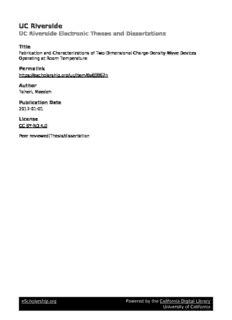Table Of ContentUC Riverside
UC Riverside Electronic Theses and Dissertations
Title
Fabrication and Characterizations of Two-Dimensional Charge-Density-Wave Devices
Operating at Room Temperature
Permalink
https://escholarship.org/uc/item/6v60867n
Author
Taheri, Maedeh
Publication Date
2017
Copyright Information
This work is made available under the terms of a Creative Commons Attribution-
NoDerivatives License, availalbe at https://creativecommons.org/licenses/by-nd/4.0/
Peer reviewed|Thesis/dissertation
eScholarship.org Powered by the California Digital Library
University of California
UNIVERSITY OF CALIFORNIA
RIVERSIDE
Fabrication and Characterizations of Two-Dimensional Charge-Density-Wave Devices
Operating at Room Temperature
A Thesis submitted in partial satisfaction
of the requirements for the degree of
Master of Science
in
Electrical Engineering
by
Maedeh Taheri
September 2017
Thesis Committee:
Dr. Alexander Balandin, Chairperson
Dr. Roger Lake
Dr. Alexander Khitun
Copyright by
Maedeh Taheri
2017
The Thesis of Maedeh Taheri is approved:
Committee Chairperson
University of California, Riverside
Acknowledgments
I would be so delighted to express my sincere gratitude to my advisor, professor
Alexander Balandin for his tremendous support, guidance, encouragement and his
dedication to science that enlightened my research work. I was so fortunate to have the
opportunity to work in Prof. Balandin’s research group, which led toward attaining great
skills and experiences that are greatly appreciated. All those learning moments are so
precious and unforgettable, which I remember through my entire life and I would be truly
grateful to Prof. Balandin for providing them.
Furthermore, I am very thankful to Prof. Roger Lake and Prof. Alexander Khitun
for their support and serving as committee members in my thesis. I also had the chance to
take classes on subjects such as semiconductor devices and quantum electron transport
with Prof. Lake, in which I learned a lot and he answered my questions with an utmost
patience, which is very appreciated. In addition, I am grateful to Dr. Tina Salguero for
providing us with high quality materials, which I implemented for device fabrications in
this work.
I would like to appreciate the help and support of my group members, people who
are among the best researchers in their kinds. First I am so grateful to Dr. Guanxiong Liu
for the knowledge and skills that he shared with me. I learned a lot from him in the areas
of device fabrications and low-frequency noise measurements. Also, I am very thankful
to Ece Aytan for her guidance and help, when I was so new to the device fabrications and
clean room instruments. I would be glad to appreciate the rest of my group members, Dr.
iv
Chenglong Jiang, Dr. Hoda Malekpour, Dr. Fariborz Kargar, Dr. Monica Lacerda, Dr.
Mohammed Saadah, Ruben Salgado, Adane Geremew, Edward Hernandez and Jacob
Lewis. Furthermore, during the fabrication steps, clean room’s staffs have provided me
with amazing training on the instruments. Therefore, I would like to thank Mark Heiden,
Dong Yan, Frank Lee and John Butler for their help and expertise.
Finally, I wish to express my sincere appreciation toward my family. My dearest
parents, Farnoosh and Mahmood Taheri, my brother, Mostafa and my husband, Masoud
Berahman. They encouraged me and supported me in every single step toward this path,
which I could not pass through without their patience and affections and I deeply cherish
them all.
v
Dedicated
To
My Parents
Farnoosh and Mahmood
v i
ABSTRACT OF THE THESIS
Fabrication and Characterizations of Two-Dimensional Charge-Density-Wave Devices
Operating at Room Temperature
by
Maedeh Taheri
Master of Science, Graduate Program in Electrical Engineering
University of California, Riverside, September 2017
Dr. Alexander Balandin, Chairperson
The charge-density-wave (CDW) phase is a macroscopic quantum state consisting of a
periodic modulation of the electronic charge density which is accompanied by a periodic
distortion of the atomic lattice in quasi-one-dimensional (1D) or layered quasi-two-
dimensional (2D) metallic crystals. Several layered transition metal dichalcogenides
(TMDs) reveal the CDW phase transitions at rather high temperatures. These transitions
can be affected by environmental conditions, film thickness and applied electric bias.
This thesis, reports results of investigation focused on developing and optimizing
fabrication procedures for devices implemented with a specific TMD - 1T polytype of
TaS . This material undergoes the transition from a nearly commensurate CDW phase to
2
incommensurate CDW phase at 350 K. This phase transition is accompanied by a lattice
reconstruction, which results in strong modifications of the material's electrical
properties. The change in the electrical characteristics in the transition point can be used
for fabricating oscillator devices operating at room temperature. In this thesis, I briefly
outline CDW theoretical background and then, describe in details the fabrication steps
vi i
required for such devices. Specifically, I describe exfoliation of the 2D material,
protection from oxidation, transfer process, spin coating, electron beam lithography,
metal deposition and lift-off process. The current-voltage characteristics of the resulting
devices show reproducibly an abrupt change in electrical current and a hysteresis loop.
The hysteresis loop can be used for building a voltage-controlled oscillator. The low-
frequency noise measurements have been conducted in a wide temperature range in order
to elucidate the physical mechanism of the phase transition and electronic transport. The
noise spectral density shows 1/f type spectrum with signature of the generation –
recombination (G-R) bulges at some bias points (f is the frequency). The obtained results
are important for developing the 2D electronic device technology based on the CDW
effects.
vi ii
Table of Contents
Chapter 1
Introduction to Charge-Density-Waves
1.1 Motivations…………………………………………….……………………………..1
1.2 Brief Concepts of Charge-Density-Waves Effects.……....…………………………..2
References………………………………………………………………………….…….12
Chapter 2
Literature Review
2.1 The Overview on 2D Materials………………...…………………………………….14
2.2 CDW Effects in 2D Materials…..……………………………………………………17
References………………………………………………………………………….…….23
Chapter 3
Fabrication Process
3.1 Introduction……………………………………………………………………….….26
3.2 Preparing Silicon Substrate……………………………………………………….….26
3.3 Exfoliation of Transition Metal Dichalcogenides……………………………………27
3.4 Protecting 1T-TaS From Oxidation……………………………………………...….30
2
3.4.1 Transfer Process…………………………………………….……………...31
3.5 Device Fabrication Steps…………………………………………………………….33
3.5.1 Fabricating Alignment Markers……………………………………………33
3.5.1.1 Spin Coating Resist Layer.…...…………………………….……33
ix
Description:Mohammed Saadah, Ruben Salgado, Adane Geremew, Edward Hernandez .. This gap can make a metal system to act as an insulator and result in.

